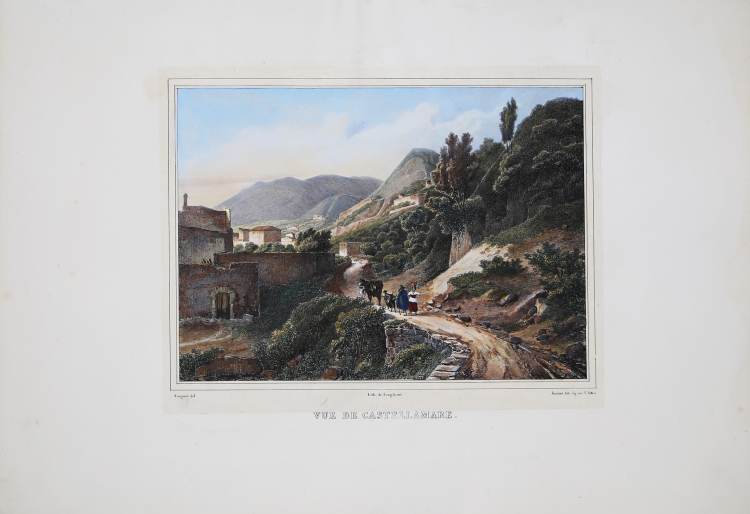


| Reference: | s35229 |
| Author | Jules-Louis-Philippe COIGNET |
| Year: | 1825 |
| Zone: | Castellamare di Stabia |
| Printed: | Paris |
| Measures: | 305 x 237 mm |


| Reference: | s35229 |
| Author | Jules-Louis-Philippe COIGNET |
| Year: | 1825 |
| Zone: | Castellamare di Stabia |
| Printed: | Paris |
| Measures: | 305 x 237 mm |
Nice view from Vues pittoresques de l'Italie dessine'es d'apre's nature, par M. Coignet, et lithographie'es par M.M. Allaux, Bichebois, Deroy, Gue', Iacottez, Joly, Mougin, Sabatier, Tirepenne, Villeneuve etc, etc, edited by Sazerac and Duval, Paris, 1825.
The work containes 36 lithographs after drawings by Jules Louis Philippe Coignet.
Lithograph, finely hand-coloured, in very good condition.
Jules-Louis-Philippe COIGNET (1798 - 1860)
|
Jules-Louis-Philippe Coignet was born in 1798. He studied with the influential neoclassical landscape painter Jean Victor Bertin (1767-1842) and in 1821 was among the competitors for the Rome Prize in Historical Landscape. From 1824 until 1857 he regularly exhibited at the Paris Salon, winning a gold medal in 1824 with View of the Gulf of Salerno (lost). A constant traveler in search of picturesque motifs, not unlike his contemporary Corot, he carried his explorations as far as Egypt and Syria. Although he had begun as a painter in the tradition of the composed, "historical" landscape, his Salon submissions were for the most part topographical views, based on oil studies painted out-of-doors. In these studies, the raw material from which he developed his exhibition pieces, he showed himself a fluent colorist, sensitive to effects of light and atmosphere: in short, a naturalist, whose painterly, observation-based work contains no trace of neoclassical stylization. Unlike other landscapists formed, like himself, in the school of Pierre-Henri de Valenciennes (175O-1819), Bertin,and Achille-Etna Michallon (1796-1822), he did not construct his landscapes piecemeal by an addition of parts but aimed from the outset for the entire image. His preliminary studies from nature already present encompassing views of the chosen sites in their proper illumination. In his finished paintings, his reliance on direct experience allowed him to dispense with the fictions by which other painters sought to heighten the significance of their landscapes. His Salon submissions contained no mythical or historical motifs. Though he was partial to evocative sites, as exemplified by one of his most successful works, Temple of Poseidon (1844, Neue Pinakothek, Munich), he rarely gave way to romantic exaggeration. It may have been this abstention from both classicist elevation and romantic drama that caused his paintings to be slighted by the critics, despite his popularity with the middle-class public in France and Germany. A prolific and careful draftsman, Coignet produced a large body of pencil drawings (many of them now at the Musée d'Art of Clermont-Ferrand) that deal in a fairly prosaic way with topographic views and landscape details such as trees, shrubbery, and rocks. Some of these were intended for lithographic reproduction in the books on landscape that Coignet published. He died in 1860
|
Jules-Louis-Philippe COIGNET (1798 - 1860)
|
Jules-Louis-Philippe Coignet was born in 1798. He studied with the influential neoclassical landscape painter Jean Victor Bertin (1767-1842) and in 1821 was among the competitors for the Rome Prize in Historical Landscape. From 1824 until 1857 he regularly exhibited at the Paris Salon, winning a gold medal in 1824 with View of the Gulf of Salerno (lost). A constant traveler in search of picturesque motifs, not unlike his contemporary Corot, he carried his explorations as far as Egypt and Syria. Although he had begun as a painter in the tradition of the composed, "historical" landscape, his Salon submissions were for the most part topographical views, based on oil studies painted out-of-doors. In these studies, the raw material from which he developed his exhibition pieces, he showed himself a fluent colorist, sensitive to effects of light and atmosphere: in short, a naturalist, whose painterly, observation-based work contains no trace of neoclassical stylization. Unlike other landscapists formed, like himself, in the school of Pierre-Henri de Valenciennes (175O-1819), Bertin,and Achille-Etna Michallon (1796-1822), he did not construct his landscapes piecemeal by an addition of parts but aimed from the outset for the entire image. His preliminary studies from nature already present encompassing views of the chosen sites in their proper illumination. In his finished paintings, his reliance on direct experience allowed him to dispense with the fictions by which other painters sought to heighten the significance of their landscapes. His Salon submissions contained no mythical or historical motifs. Though he was partial to evocative sites, as exemplified by one of his most successful works, Temple of Poseidon (1844, Neue Pinakothek, Munich), he rarely gave way to romantic exaggeration. It may have been this abstention from both classicist elevation and romantic drama that caused his paintings to be slighted by the critics, despite his popularity with the middle-class public in France and Germany. A prolific and careful draftsman, Coignet produced a large body of pencil drawings (many of them now at the Musée d'Art of Clermont-Ferrand) that deal in a fairly prosaic way with topographic views and landscape details such as trees, shrubbery, and rocks. Some of these were intended for lithographic reproduction in the books on landscape that Coignet published. He died in 1860
|